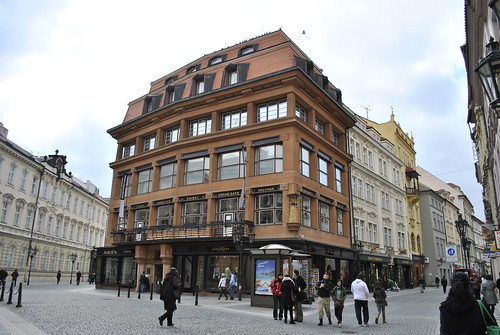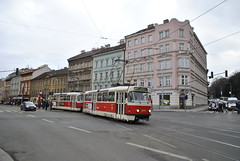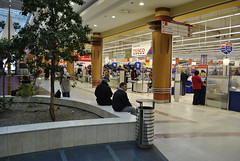
Spring break was three weeks ago now, following a week-long class trip to the Veneto region of Italy. My friend Spencer came to visit and we traveled to Prague and Paris during the week with a couple days in Rome at both ends.
We flew from Rome to Prague Monday afternoon (March 15) and were there through early Thursday morning. Despite colder temps and cloudy skies, first impressions of Prague were good. The Prague Airport is nice and new and transportation into the city was easy and inexpensive. A 26 CZK (about $1.50) transit ticket got us a city bus ride and Metro trip to the city center where we were staying. Prague is a transit-intensive city with several metro lines, bus routes and surface tram lines. Like everywhere else I’ve visited in Europe, the bus and tram systems use the honor system where passengers must validate a transit ticket when they board, but oddly the subway metro system also uses this form of payment, instead of a typical access-controlled system with turnstiles or automatic gates. It was quite unusual to be able to just walk freely into the metro. Similar to Rome, a standard ticket permits 75 minutes of unlimited travel.
 On Tuesday we walked around the city center hitting most of the significant places and sites. The city is large but the old center is quite compact with everything being pretty walkable. Except near the train terminal, everywhere we went was well-maintained and clean. Streets were mostly asphalt or cobblestone with sidewalks paved in decorative cube stones. The urban layout is much more consistent and contingent than in Rome where medieval streets mesh with modern wide thoroughfares and areas are disjointed by ancient ruins. Prague’s architecture is definitely distinct from Rome and more quintessential European. The majority of building facades are painted and pastel tones, making for a very colorful city.
On Tuesday we walked around the city center hitting most of the significant places and sites. The city is large but the old center is quite compact with everything being pretty walkable. Except near the train terminal, everywhere we went was well-maintained and clean. Streets were mostly asphalt or cobblestone with sidewalks paved in decorative cube stones. The urban layout is much more consistent and contingent than in Rome where medieval streets mesh with modern wide thoroughfares and areas are disjointed by ancient ruins. Prague’s architecture is definitely distinct from Rome and more quintessential European. The majority of building facades are painted and pastel tones, making for a very colorful city.
Worth mentioning – the Czech Cubism Museum, housed in the House of the Black Madonna (top photo), the first and most prominent example of cubist architecture in Prague, built in 1912. The exhibit included cubist paintings, sculpture, furniture, and architectural drawings. Very interesting to learn more about an architectural and art movement so specific to Czech, and Prague in particular.
Another major site was the Prague Castle, an enormous, eclectic compound looking over the city of Prague. Dating back to the 9th century AD, several additions of the centuries has made it one of the largest castles in the world, including the Gothic cathedral, St. Vitus. We walked up to the castle, which permits fantastic views of the city, and walk through the outside, not actually going in. We did stop in the cathedral, which was my first Gothic cathedral to experience in person. The space was incredible. The interior height is emphasized by the structural expression of the Gothic style.
For dinner we had some typical Czech fare – dumplings, pork, sauerkraut, and the pub’s beer sampler. We ended up sitting at the end of a table shared with two other men. Evidently most dinning out in Prague is done by reservation.
 Wednesday, among exploring the city center more on foot, we took the metro to the Žižkov Television Tower, to take in the 360 view from the observation level. Additionally we stopped back at the Nový Smíchov shopping center just a few blocks south of our hotel in the middle of a busy, redeveloped neighborhood called Anděl. The three level shopping center was comparable to American malls on the inside, but the exterior was tastefully hidden behind a long street facade of existing four-five story buildings, with a contemporary glass entrance opening up at one end to a street space surrounded by several other modern glass buildings and a busy tram stop. Nový Smíchov included a movie ciniplex and a full-sized Tesco store, a UK-based big box retailer similar to Walmart.
Wednesday, among exploring the city center more on foot, we took the metro to the Žižkov Television Tower, to take in the 360 view from the observation level. Additionally we stopped back at the Nový Smíchov shopping center just a few blocks south of our hotel in the middle of a busy, redeveloped neighborhood called Anděl. The three level shopping center was comparable to American malls on the inside, but the exterior was tastefully hidden behind a long street facade of existing four-five story buildings, with a contemporary glass entrance opening up at one end to a street space surrounded by several other modern glass buildings and a busy tram stop. Nový Smíchov included a movie ciniplex and a full-sized Tesco store, a UK-based big box retailer similar to Walmart.
That evening we ate at a pretty good Thai restaurant and returned to the hotel pretty early because our early flight to Paris in the morning. We had to get around 3:30 to catch a night bus back to the Prague airport. It was very convenient, going right by our hotel. Prague was a very nice city to visit, modest and well-maintained. Architecturally it is a historic city that does not resist contemporary interventions.
See all my photos from Prague here.


